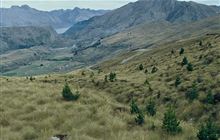When Christmas trees go rogue
Archived content: This media release was accurate on the date of publication.
Introduction
The woody scent of pine wafting through your house is part of the magic of Christmas, but local conservationists are working hard to ensure pine trees are enjoyed in the right place.Date: 20 December 2018
Led by conservation volunteers Anthony Behrens and Fiona Burleigh, the Palmy Pine Pullers Posse have been working to remove wilding pine from the Ruahine Forest Park, around Kashmir Roadend.
Wilding pine is the New Zealand term for introduced conifers that are spreading across the landscape – self-sown and unwanted.
The Palmy Pine Pullers Posse is a group of local conservationists who recognised a problem in their backyard and decided to take action. It began on a tramp to Longview Hut five years ago.
“We came down from the hut and just started pulling,” explained Anthony. “We were shattered after a couple of hours. It’s hard work but weirdly satisfying because the impact of what we are doing is instant.”
There are currently ten volunteers in the posse. They pull out smaller saplings by hand and cut the larger ones with silky saws, then paste the stumps with herbicide. For now, they are focusing on clearing wilding conifers from the area around the Kashmir Roadend car park.
Anthony says they have removed more than 7000 wilding pines from the area but there is still plenty of work to be done.
DOC predicts that 20% of New Zealand will be invaded by wilding pine forests within 20 years without rapid action. Wilding conifers currently cover more than 1.8 million ha of land and are spreading at an estimated rate of 5% a year.
When conifer cones mature on the tree, they open to release masses of wind-blown seeds. These seeds spread for miles and can take root and grow almost anywhere.
Wilding conifers take over native landscapes, killing indigenous vegetation and evicting native wildlife. They also have a huge impact on our economy. They suck valuable water out of catchments, they add big costs to farming and they impact on tourism and recreational opportunities.
“The management of wilding conifers is a massive task,” says Nicole Sutton, acting DOC Operations Manager for the Manawatu District. “Community volunteer groups like the Palmy Pine Pullers Posse make a vital contribution, but it will take a little effort from everyone.”
The New Zealand Wilding Conifer Management Strategy provides a framework for government, forestry and farming industries, landowners, researchers and communities to work together to reduce the negative impacts of wilding conifers.
You can help
- Dispose of garden waste wisely, including discarded Christmas trees.
- Join a weed group – like the Palmy Pine Pullers Posse – that protects our unique landscapes and native plants and animals from wilding conifers.
- Reporting observations on iNaturalist to help map the distribution of wilding conifers.
- Control wilding conifers on land you manage.
More about conifers
Ten introduced conifer species are responsible for most of the wilding conifers.
- Lodgepole or contorta pine (pinus contorta): The most aggressive species with the youngest coning age and farthest spread. Has been declared an unwanted organism under the Biosecurity Act 1993 since 2001, which means it cannot be bred, propagated, distributed or sold.
- European larch (larix decidua): A distinctive deciduous conifer that can be invasive in wetter areas.
- Corsican pine (pinus nigra): Slower to mature than lodgepole or contorta pine but can spread very large distances.
- Radiata pine (pinus radiata): The most common commercial timber species that can spread in lowland situations and affect native bush regeneration.
- Maritime pine (pinus pinaster): Very large tree that often grows in association with radiata pine in coastal areas.
- Ponderosa pine (pinus ponderosa): Historically grown as an amenity tree in very dry areas where it often spreads.
- Scots pine (pinus sylvestris) and Bishop pine (pinus muricata): These two species are rarely grown for timber but have spread from early trial sites.
- Dwarf mountain pine (pinus mugo): A short bushy species that was planted in alpine areas. It has spread slowly but is very hard to kill.
Radiata pine and Douglas fir are also important commercial species, but only when the trees are planted in an appropriate place, at suitable spacings, and tended as they grow.
Contact
Kelly Hancock
Community Ranger, DOC Manawatu
Mobile: +64 27 290 9231
Email: khancock@doc.govt.nz

